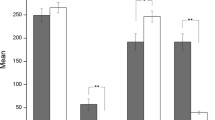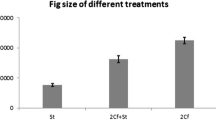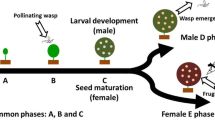Abstract
Active pollination, although rare, has been documented in a few pollination mutualisms. Such behaviour can only evolve if it benefits the pollinator in some way. The wasps that pollinate Ficus inflorescences can be active or passive pollinators. They lay their eggs in fig flowers, so that a proportion of flowers will host a wasp larva instead of a seed. We show in an actively pollinated monoecious fig that lack of pollination does not induce fig abortion or affect wasp offspring size but results in smaller numbers of offspring. Hence, conversely to other active pollination systems, seed formation is not obligatory to sustain developing pollinator larvae; however there is a direct fitness cost to active pollinators not to pollinate. We then compared the locations of eggs and fertilised flowers of three actively pollinated Ficus species and one passively pollinated species. We found that more flowers containing wasp eggs were fertilised in the actively pollinated species relative to those of the passively pollinated one. These results along with comparison with similar studies on dioecious figs, support the hypothesis that active pollination has evolved in fig wasps to ensure that more flowers containing wasp eggs are fertilised as this may increase the chances of successful gall development. The stigmatic platform characterising actively pollinated figs is probably an adaptation to increase pollen dispersion within the fig.


Similar content being viewed by others
References
Anstett MC (2001) Unbeatable strategy, constraint and coevolution, or how to resolve evolutionary conflicts: the case of the fig/fig waps mutualism. Oikos 95:476–484
Axelrod F, Hamilton WD (1981) The evolution of cooperation. Science 211:1390–1396
Berg CC (1989) Classification and distribution of Ficus. Experientia 45:605–611
Compton SG, Holton K.C. RVK, Van Noort S, Vincent SL, Ware AB (1991) Studies of Ceratosolen galili, a non-pollinating agaonid fig wasp. Biotropica 23:188–194
Crawley MJ (1993). Glim for ecologists. Blackwell, Oxford
Fleming TH, Holland JN (1998) The evolution of obligate pollination mutualisms: senita cactus and senita moth. Oecologia 114: 368–375
Frank SA (1984) The behaviour and morphology of the fig wasps Pegoscapus assuetus and P. jimenezi : descriptions and suggested behavioral characters for phylogenetic studies. Psyche 91:289–308
Galil J, Eisikowitch D (1968) On the pollination ecology of Ficus religiosa in Israel. Phytomorphology 18:356–363
Galil J, Eisikowitch D (1969) Further studies on the pollination ecology of Ficus sycomorus L. (Hymenoptera, Chalcidoidea, Agaonidae). Tijdschr Entomol 112:1–13
Galil J, Eisikowitch D (1971) Studies on mutualistic symbiosis between syconia and sycophilous wasps in monoecious figs. New Phytol 70:773–787
Galil J, Meiri L ( 1981) Number and structure of anthers in fig syconia in relation to behaviour of the pollen vectors. New Phytol 88:83–87
Galil J, Neeman G (1977) Pollen transfer and pollination in the common fig (Ficus carica L.). New Phytol 79:163–171
Ganeshaiah KN, Kathuria P, Shaanker RU, Vasudeva R (1995) Evolution of style-length variability in figs and optimization of ovipositor length in their pollinator wasps: a coevolutionary model. J Genet 74:25–39
Gibernau M, Hossaert-McKey M, Anstett M-C, Kjellberg F (1996) Consequences of protecting flowers in a fig: a one-way trip for pollinators ? J Biogeogr 23:425–432
GLIM (1985) GLIM. Royal Statistical Society, London
Greeff JM, Compton SG (1996) Sequential oviposition and optimal sex ratios in pollinating fig wasps. Ecol Entomol 21:300–302
Herre EA (1989) Coevolution of reproductive characteristics in 12 species of New World figs and their pollinator wasps. Experientia 45:637–647
Herre EA (1999) Laws governing species interactions? Encouragements and caution from figs and their associates. In: Keller L (ed) Levels of selection. Princeton University Press, Princeton, N.J., pp 209–235
Herre EA, West SA (1997) Conflict of interest in a mutualism: documenting the elusive fig wasp-seed trade-off. Proc R Soc Lond B 264:1501–1507
Holland JN, Fleming TH (1999) Mutualistic interactions between Upiga virescens (Pyralidae), a pollinating seed-consumer, and Lophocereus schotti (Cactacae). Ecology 80:2074–2084
Huth CJ, Pellmyr O (2000) Pollen-mediated selective abortion in yuccas and its consequences for the plant-pollinator mutualism. Ecology 81:1100–1107
Janzen DH (1979) How to be a fig. Annu Rev Ecol Syst 10:13–51
Jousselin E (2001) Evolution du mode de pollinisation dans le mutalisme Ficus/Agaonidae. Phd Thesis (unpublished). ENSAM, Montpellier, France
Jousselin E, Kjellberg F (2001) The functional implications of active and passive pollination in dioecious figs. Ecol Lett 4:151–158
Jousselin E, Hossaert-McKey M, Vernet D, Kjellberg F. (2001) Egg deposition patterns of fig pollinating wasps: implications for studies on the stability of the mutualism. Ecol Entomol 26: 602–608
Kearns CA, Inouye DW (1993). Techniques for pollination biologists. Colorado University Press, Colorado, Colo.
Kjellberg F, Michaloud G, Valdeyron G (1987) The Ficus-pollinator mutualism: how can it be evolutionary stable? In: Labeyrie V, Fabres G, Lachaise D (eds) Insects-plants. Junk, Amsterdam, Netherlands, pp 335–340
Kjellberg F, Jousselin E, Bronstein J, Patel A, Yokoyama Y, Rasplus JY (2001) Pollination mode in fig wasps: the predictive power of correlated traits. Proc R Soc Lond B 268:1113–1121
Machado CA, Jousselin E, Kjellberg F, Compton SG, Herre EA (2001) Phylogenetic relationships, historical biogeography and character evolution of fig-pollinating wasps. Proc R Soc Lond B 268:685–694
Nefdt RJC (1989) Interactions between fig wasps and their host figs. PhD thesis, Rhodes University, Grahamstown, South Africa, pp1–170
Nefdt RJC, Compton SG (1996) Regulation of seed and pollinator production in the fig-fig wasp mutualism. J Anim Ecol 65:170–182
Pellmyr O (1997) Pollinating seed eaters: why is active pollination so rare? Ecology 78:1655–1660
Ramirez W (1969) Fig wasps: mechanism of pollen transfer. Science 163:580–581
Rasplus J-Y (1996) The one-to-one species specificity of the Ficus -Agaonidae mutualism: how casual? In: Van der Maesen LJG, Van der Burgt XM, Van Medenbach de Rooy JM (eds) The biodiversity of African plants. Kluwer, Dordrecht, pp 639–649
Riley C (1892) The Yucca moth and yucca pollination. Annu Rep Mo Bot Gard 3–99
Rohfritscht O (1992) Patterns of gall development. In: Shorthouse JD, Rohfritscht O (eds). Biology of insect-induced galls. . Oxford University Press, Oxford, pp 60-86
SAS (1999) SAS user's guide. SAS Institute, Cary, N.C.
Thompson JN (1989) Concepts of coevolution. Trends Ecol Evol 4:179–183
Valdeyron G, Lloyd DG (1979) Sex differences and flowering phenology of the common fig, Ficus carica L. Evolution 33:673–685
Verkerke W (1989) Structure and function of the fig. Experientia 45: 612–622.
Weiblen GD (2000) Phylogenetic relationships of functionally dioecious Ficus (Moraceae) based on ribosomal DNA sequences and morphology. Am J Bot 87:1342–1357
West SA, Herre EA, Windsor DM, Green PRS (1996) The ecology and evolution of the New World non-pollinating fig wasp communities. J Biogeogr 23:447–458
Yokoyama J (1995) Insect-plant coevolution and cospeciation. In: Arai R, Kato M, Doi Y (eds) Biodiversity and evolution. National Science Foundation, Tokyo, pp 115–130
Acknowledgements
This research was partly supported by a Brunei Shell Environmental Studies Fellowship and a CNRS and NRF combined s & t grant. We are grateful to Dr D. Edwards and to the Biology department staff at Universiti Brunei Darussalam for their help. We also acknowledge the Director of the Brunei Museum and the Forestry Department for allowing us to export specimens. Many thanks to Jaco Greeff and Simon van Noort for their help in finding and identifying fig trees in the field. We thank C. Brouat, J. Greeff, D. McKey, J. Pienaar and J. Shykoff for advice on earlier versions of this manuscript.
Author information
Authors and Affiliations
Corresponding author
Rights and permissions
About this article
Cite this article
Jousselin, E., Hossaert-McKey, M., Herre, E.A. et al. Why do fig wasps actively pollinate monoecious figs?. Oecologia 134, 381–387 (2003). https://doi.org/10.1007/s00442-002-1116-0
Received:
Accepted:
Published:
Issue Date:
DOI: https://doi.org/10.1007/s00442-002-1116-0




